Bonsai requires patience, the ability to contemplate and organization. A perennial plant may disappear in one day from the wrong dose of fertilizer, too bright sun or drying out of the roots. Trees of real masters who know how to grow bonsai resemble living sculptures, a work of art.
Material Content:
Japanese Bonsai Tree: Description
A plant grown in a flower pot using a special technology is called bonsai. Its size can be from two dozen centimeters to 2 meters.
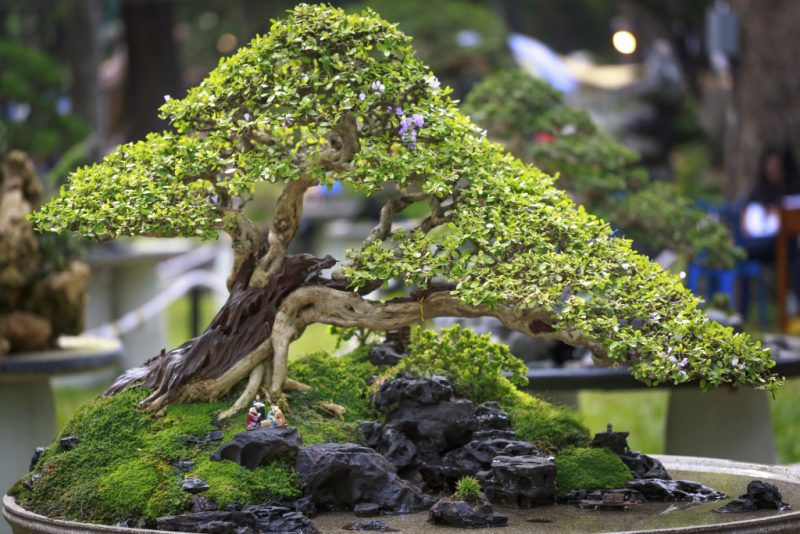
This is most often a tree (maybe grass), which has a thick trunk, a special slope of the branches, aerial roots. Each composition is made in a certain style.
Features of growing bonsai
Several hundred plant species are suitable for creating bonsai. There are various directions in this art. Sometimes, for example, they grow more than one tree in a flower pot, but create a small natural corner with a miniature pond and mountains.
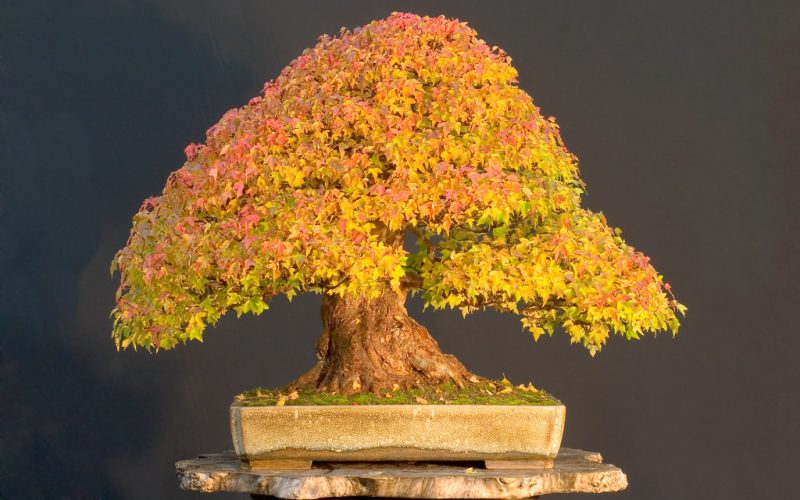
- Coniferous bonsai trees are especially valued, they are hardy to cold, and the compositions created with their use look extraordinary.
- Beautiful flowering miniature trees - jacaranda, acacia, myrtle, magnolia.
- You can grow a small fruiting plant in the style of bonsai - peach, pomegranate, orange, lemon, plum. The choice depends on the growing conditions.
- Coniferous trees in winter need a lower air temperature, and in a hot room it is better to grow dracaena, hibiscus, ficus.
Common ways to grow bonsai at home
You can grow a bonsai tree from a seedling purchased at a flower shop, or purchase a ready-made composition.You can start the independent formation of a plant in the chosen style from the age of 2.
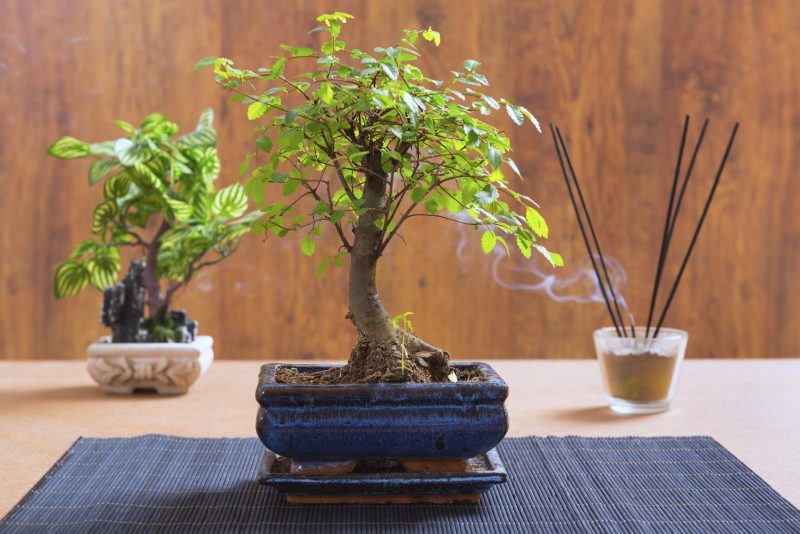
Growing Tips:
- Plants with large leaves, flowers or fruits are not suitable for creating a miniature composition. Small-leaved varieties are selected from representatives of one plant family.
- It helps to grow a miniature tree in a diary in which all the pruning and care procedures are preplanned.
- They select plants that are hardy to the local climate or evergreen, adapted to a warm room all year round.
- How to grow bonsai from seeds will help to understand experiments with ordinary stone fruits or pome crops of moderate latitude.
In addition to pruning, thick copper wire is used to give the tree the desired shape.
. A barrel wrapped in wire to create a tilt or bend is left locked in position for 2 years. The side branches are kept in a vice of wire for at least 8 months so that they take the right direction.
Pot and soil selection
Choosing a bonsai bowl is an important point in growing. All landing tanks differ in shape and material of manufacture. Coloring the container is always simple, without bright patterns.

Badges are:
- plastic;
- ceramic with pallets;
- ceramic without pallets.
The advantage of plastic cups is their cheapness. They are almost always sold with pallets. However, if the plants are taken outside in the summer, the plastic, especially the dark one, will become very hot, and the root system will suffer from overheating. Plastic containers are also not suitable for plants made in an inclined style - deviating from the central axis, they create an unstable composition. For this reason, the capacity for their landing needs a heavy and wide.
Plates are deep and not very wide used for miniature trees with aerial roots. High tanks are suitable for growing cascading styles when trees form with a hanging crown.
At the bottom, the bonsai pot has openings for draining water, which, when planting, must be covered with a net. If there are no holes, they are made independently - in a ceramic container with a drill, in plastic - with a hot screwdriver. Before planting, wash the container and pour boiling water over it.
Special soil requirements. Traditional Japanese bonsai are planted in acadama - these are clay granules of various fractions.
Such soil is found in nature in the Japanese province of Kanto. Plants are rarely planted in pure acadama.
On sale there are special soil mixtures that are suitable for growing miniature trees, with a neutral environment and without peat.
Bonsai tree care at home
Bonsai has special watering requirements because the land dries quickly.

Interestingly, to moisten dense soil using the method of immersion in a container of water.
It is necessary to moisten the entire earthen lump so that the water spills into the pan through the drainage holes. Water is immediately drained from the pan.
You must also take into account the type of plant, making up a watering schedule for yourself.
- Coniferous trees and succulents can be watered less often, because the former evaporates less moisture, and the latter stores it in leaves.
- A tree with a lush crown, originally from tropical rainforests, such as ficus bonsai, needs frequent watering and high humidity.
Water quality for irrigation is of great importance. Hard water can not be used, only rain or passed through a special filter with ion-exchange resins will do. Otherwise, a white coating forms on the surface of the soil and on the tree trunk, which does not peel off. Soft water is also used for spraying, the temperature of which is several degrees higher than the surrounding air.
Plants are fed once a week in the spring and summer, and once a month in winter.
To do this, use special fertilizers for bonsai or conventional, diluted 2 or 3 times weaker than recommended by the instructions. An overdose of miniature trees is fatal.
Coniferous trees and boxwoods need special top dressing, which can be bought at the garden center, it contains special components that are not found in hardwood preparations.
It is interesting:alocasia at home
Immediately after pruning or replanting plants, fertilizers must not be applied. Before flowering or during it, feeding is also undesirable. For example, myrtle will not bloom with an excess of fertilizer in the soil. If the plant has problems - it was attacked by pests or diseases - feeding should also be abandoned.
Important pruning tips
Formed copy of the bonsai should look as natural as possible. Therefore, the finished shape that the tree will take must be presented from the very beginning of the pruning.

This procedure is usually performed annually at the end of winter. If the plant blooms, pruning is done after flowering. All slices are treated with special paste (for example, "Runnet"), it can be bought at flower shops.
Trim the ends of the shoots, giving the crown the desired shape, throughout the growing season. This stimulates branching of new shoots.
Nailing is performed either in early spring, or several times per season.
In bonsai, roots are also pruned during transplantation. It is advisable to do this when the root system grows, completely filling the space of the bowl. All diseased and damaged roots, if any, are also cut.
Problems, Diseases and Pests
Problems with growing are associated with violation of the rules of care - untimely watering, improper feeding, insufficient or excessive lighting, etc.
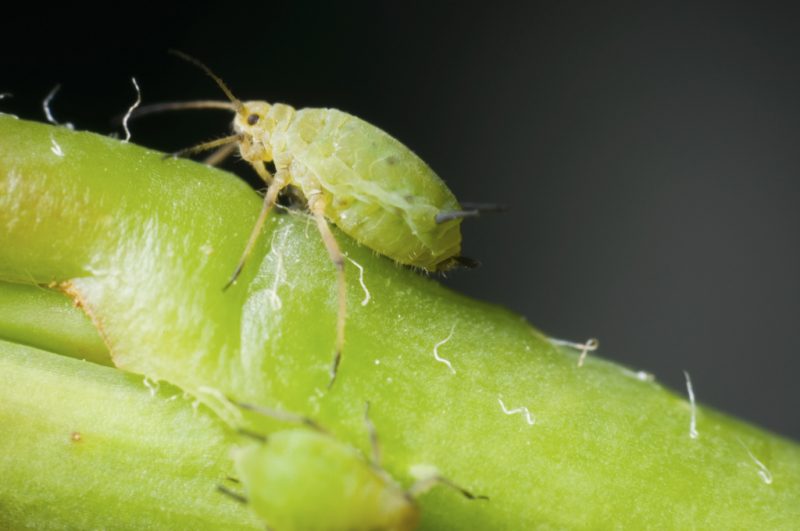
Pests on bonsai settle the same as on other indoor flowers - scale insects, thrips, aphids, spider mites.
If the plant stands in the garden in summer, it can be defeated by caterpillars and ants. To control the use of insecticides - Fitoverm, Aktaru, Confidor, etc.
Bonsai diseases associated with fungal infections - gray rot, powdery mildew, rust, root rot - are treated with fungicides, treating the diseased plant several times with an interval of 7 days.
What does the bonsai tree symbolize
Different styles of bonsai have their secret meaning, which is understood only by the initiates.
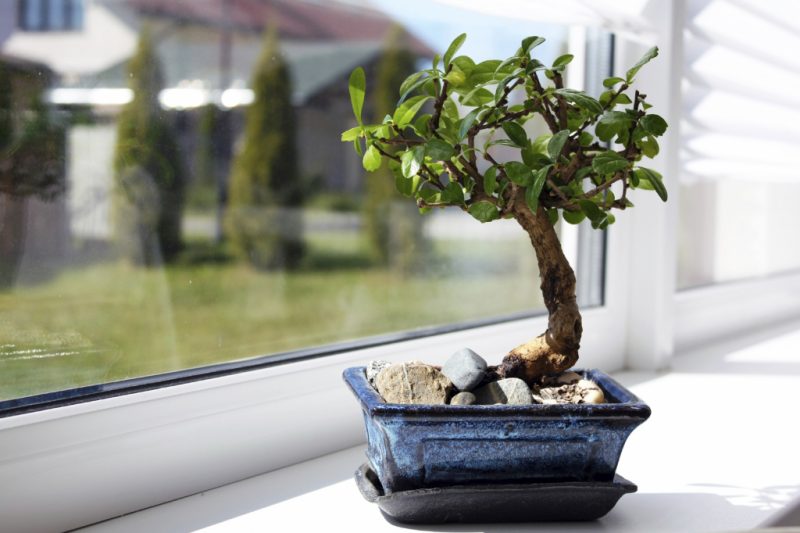
Description of some styles and symbols:
- hokidati is a symbol of calm and stability, tree branches are evenly directed to the sides, resembling a broom;
- fukinagashi - resistance to all elements, a tree growing on the coast, its branches and roots are directed towards the inclined trunk;
- hankengai - a symbol of plasticity on the edge of the abyss, the tree is tilted down, forms a half-cascade of short thickened branches;
- neagari - a strong connection with the earth, the tree rises on the roots, as on stilts;
- Isitsuki - the indestructibility and omnipotence of life, a tree growing on a rock;
- Sokan - a connection between generations and traditions, two trees of different sizes, growing from one root, etc.
So, we can safely say that bonsai is an attempt to express inner philosophy through contemplation of the surrounding world.












